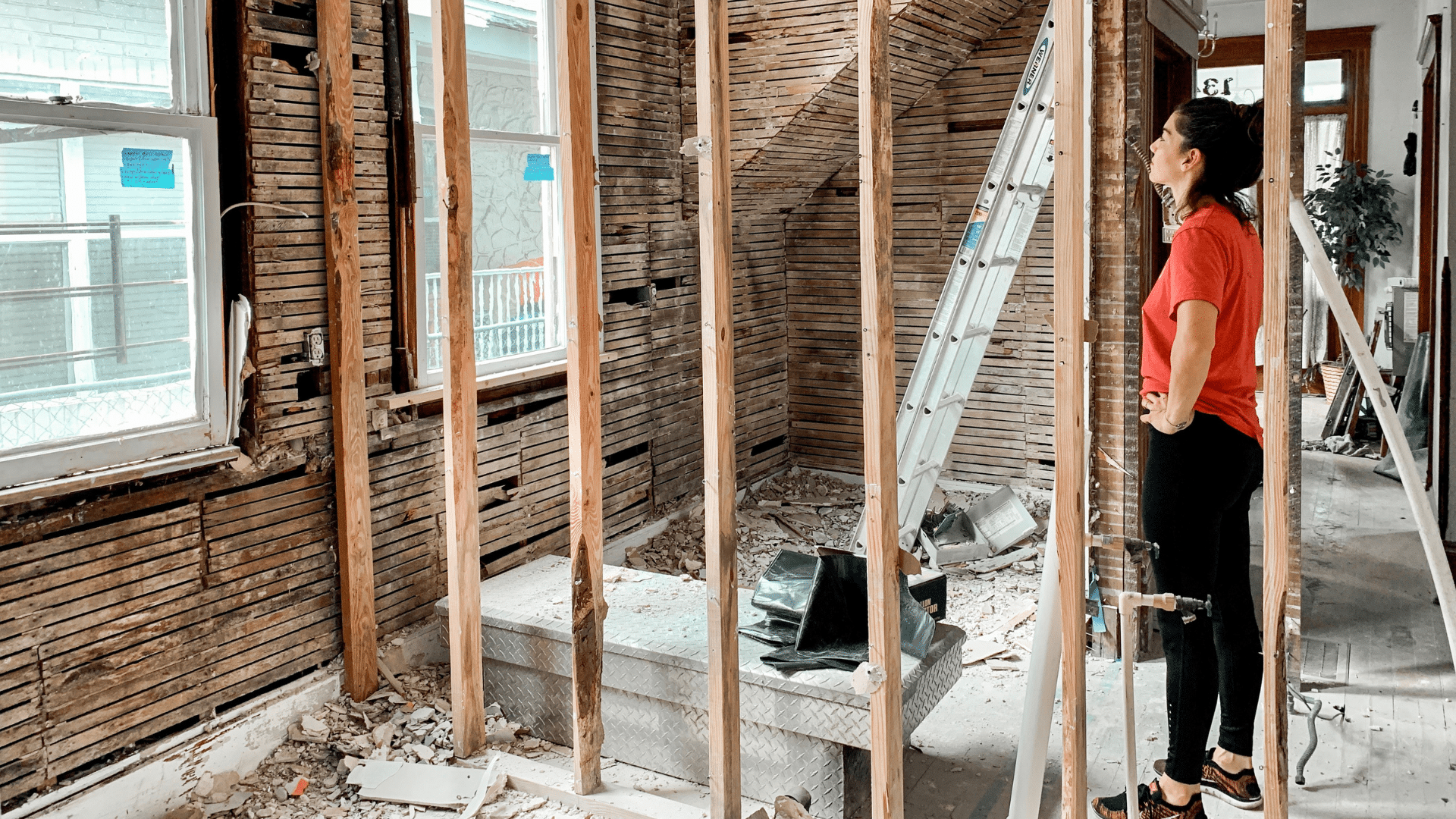This article may contain affiliate links. We may receive a commission for purchases made through these links. Privacy Policy.
Looking to add a little summer fun to your backyard? As more and more families spend time at home, many are looking for new ways to bring favorite activities to the home front.
If getting to your neighborhood pool or jetting off to a sunny resort is out of the question for your family at the moment, you may just want to consider adding an above-ground swimming pool to your yard.
Above-ground pools offer a plethora of benefits:
- They’re more affordable than in-ground pools.
- They don’t tear up your yard like installing an in-ground pool will.
- They’re fun for the entire family.
- They come in a variety of sizes and materials, as well as a range of water depths.
But buying an above-ground pool, while more affordable than an in-ground pool, is still a decision you won’t want to take lightly. A new pool is always an investment.
So, how can you make sure you’re making the right above-ground pool decision for your family? Check out our most essential tips for buying an above-ground pool below.
Choose the Right Type of Above-Ground Pool for Your Family
When someone says “above-ground pool,” you probably envision one particular type of pool. Maybe it’s an above-ground pool that you had as a kid. Perhaps it’s an above-ground pool that your grandparents had at their house. Whatever the case, you probably think of one particular design.
But there are tons of different types of above-ground pools for you to choose from when you decide to purchase your own, and you want to understand these options before you find the best choice for your family.
Traditional Above-Ground Pools

The most popular and most “traditional” above-ground pool is made from steel or resin and is your typical, round, four-foot-deep pool with a pool liner. Circumference and materials can differ, which affects price, but for the most part, these pools are considered relatively affordable compared to their in-ground counterparts. Resin pools are often the most expensive, but their pool walls are corrosion-resistant, making them higher quality.
You can usually put one of these pools together yourself, with a bit of DIY effort, but you can also often pay someone else to do the hard work for you.
Traditional above-ground pools come in both circular and oval shapes, and you can purchase them in a range of sizes, from 12 feet in diameter up to 33 feet in diameter. In general, circular pools, regardless of your pool’s overall size, are more affordable than oval pools.
Most families find these traditional, above-ground round pools to be precisely what they need and expect, and you can’t deny that the starting price at around a thousand dollars is pretty attractive.
Partial Above-Ground Pools

If you want to upgrade your above-ground pool to have more of the feel and appearance of an in-ground pool, you can purchase an above-ground pool that’s designed to sink a few feet into the ground. While this does require you to dig a hole in your backyard, it doesn’t require any of the complex construction that an in-ground pool requires. There’s no need for concrete or tiling. All you need is the hole, the above-ground pool and possibly some landscaping to go around the still-exposed upper few feet of the pool.
Just keep in mind, if this option sounds appealing, you don’t want to just decide to bury your regular, above-ground pool on a whim. You want to purchase a specifically designed partial above-ground pool. These do come with a higher price tag, usually a few additional thousand dollars above the cost of a traditional above-ground pool.
Inflatable Pools

Inflatable pools are technically still considered above-ground pools, but they vary to an extreme level in terms of size, quality and price. You can purchase a two-foot inflatable pool for just the kids, or you can get a larger, four-foot-deep inflatable pool that works for the entire family.
Inflatable pools don’t have the level of quality you’ll get with a traditional above-ground pool, and you’ll have to watch for punctures and other damage, but you get what you pay for with inflatable pools. Price tags for these pools can run as low as a few hundred dollars.
Related: The 15 Best Swing Sets For Kids Of All Ages [Complete Guide]
Consider the Extra Costs
When picking your pool, if cost is an essential factor for your family, keep in mind the extra costs that come with upkeep. It’s not just the cost of the pool itself and possibly some above-ground pool installation.
You’ll also need to purchase any landscaping materials or decking that you want to install around your pool, a cover, a pool ladder, a pump and filter, a skimmer and any necessary pool chemicals for the pool water. Additionally, there’s the cost of filling the pool with water, as well as the cost of the electricity needed to constantly run the pool pump and filter.
You may also have to pay additional fees on your homeowner insurance once you install a pool. Your insurance agent can verify, as well as let you know if their policy requires you to install any fencing alongside your pool.
While not always a necessary cost, some pool owners like to purchase fencing to put around their pool to keep kids and pets out of the water when not supervised. Others also choose to buy automatic cleaners to cut down on maintenance time. Other luxuries that you can purchase for your above-ground pool include pool lights and pool heaters.
Remember that adding a pool to your property won’t necessarily increase your home’s value if you’re trying to build equity. It will, however, give you plenty of fun afternoons and weekends with your family and loved ones, which makes it a worthy investment regardless.
Consider the Time and Effort Required

Regardless of what kind of pool you choose, it will need a little bit of maintenance on a regular basis.
You’ll want to run your pool filter at least 12 hours per day, if not all day. You’ll need to regularly test your pool’s pH level, as well as the chlorine level. Striking the perfect balance of chlorine is vital to ensure your pool is safe for swimmers. You’ll also need to keep your pump clean.
Daily tasks for keeping your pool swimmable include:
- Testing the pH level (it should be between 7.4 and 7.6).
- Testing the chlorine level (it should be between 2.0 and 4.0 ppm).
- Running the pool filter.
- Monitoring the water level.
- Checking your pump.
Every week or so, you’ll want to thoroughly clean your pool, add pool cleaners and chemicals as needed and clean up any surrounding landscaping or decking.
If you choose to go with an inflatable pool, you can find some versions that do not feature a pump, which lessens the amount of maintenance required.
And don’t forget — a pool requires additional care before the winter season hits, too. If you do not have an inflatable pool that deflates and packs away ahead of the winter months, you’ll have to winterize your above-ground pool, which includes adding your winter chemicals, removing all of the pool accessories, lowering the water level and covering your pool.
Related: The 9 Best Portable Speakers For Your Summer Adventures
Choose the Right Pool Space

Once you’ve decided on the right pool for your family, you’ll want to choose and prep your pool space correctly. Don’t just assume that you can purchase the pool, pick a spot on the lawn and you’re good to go. There are a few things you’ll definitely want to consider.
First, you’ll want to pick a relatively flat spot. If you don’t have a completely flat area in your backyard, you’ll have to level that location out. This can be done with some digging or sand (which you can purchase by the bag at your local hardware store).
If you’ve decided to go with an inflatable pool, you’ll also want to consider your surface area. If it’s a rocky section of your lawn, that can pose a threat to your inflatable pool, so you’ll want to clear all those rocks away.
Also, consider the view you’ll have from your pool. While this isn’t as important a consideration, it’s still one to consider. You don’t want to be staring into your neighbor’s yard every time you take a dip. You also may want to position the pool so that you can see it and your playing kids from a convenient window in the house.
Remember that your pool will result in some splashing and discarded water, especially if you have young kids. Your pool is going to lose water over time. With that in mind, maybe don’t choose a spot right next to your flower garden, where the chlorinated water could prove hazardous to your plants.
Consider keeping your pool away from trees, too. While the shade may seem nice, remember that trees will drop leaves, twigs and other matter into your pool, creating more work for you and clogging your filtration system.
Additionally, keep your pool away from any overhead power lines but close enough to outlets or an outdoor breaker box. This will help you efficiently run your electrical cords from your pool pump and filter to an outlet; otherwise, you’ll need to buy some extension cords.
You’ll also want to check your city restrictions on pool placement and guidelines, if there are any, as well as any restrictions set by your homeowner association if you have one.
Read the Reviews

Whatever type of pool that you decide to go with, make sure to read the reviews online. Watch out for pools that are easily damaged or that come with other mechanical issues. Pay attention to how difficult buyers say the installation process was for them. Look for pools that last for years, as well as pools that live up to the buyers’ expectations.
The last thing you want is to make your purchase and then end up with a broken pool and a yard full of water within a few weeks.
If you hire someone to install your above-ground pool, rather than handling the installation process yourself, shop around for installation quotes (but don’t shop too much — three or four quotes is enough to give you a good selection without overwhelming you). You want an installer who’s willing to actually come out to your home and give you a quote in person so that they can adequately assess your yard and how much time, effort and materials the installation will require. Ask the installer how long the installation process will take and if they have any previous clients’ referrals. You can also check review sites like Angi’s List for more info.
Consider Your Timing
There are two great times to buy a swimming pool. First, there’s the fall, when the summer’s stock of swimming pools goes on sale, and you can usually find a pretty good price. Then, there’s the spring.
While you may pay full price for a swimming pool in the spring, you get the joy of actually using the pool sooner rather than later. Getting that discounted pool in the fall is excellent for your wallet, but it does mean that you have to set it up and prep it for winter, and then you end up waiting five or six months before you actually get to use it.
What’s the Best Above-Ground Pool for Me?

Still not sure what type of above-ground pool is the perfect pool for you?
If you detest pool maintenance and want something easy and extremely affordable, go with an inflatable above-ground pool for now. You can always upgrade to something more high-quality at a later time.
If you want something mid-range, family-friendly and one you can install yourself, go with a traditional above-ground pool.
If you don’t mind splurging a bit and you want the most bang for your buck, as well as the most aesthetically pleasing option, consider a partially buried above-ground pool, along with some decking and landscaping.
You might also be interested in: Gas vs. Charcoal: The Ultimate Summer Grill Battle [Guide]
Holly Riddle
view postHolly Riddle
Holly Riddle is a travel, food and lifestyle writer, and a full-time freelance content creator after several years on editorial staffs for a multitude of publications ranging in topic and audience demographic. She currently acts as the editor at large for Global Traveler magazine and is a regular contributor at Trazee Travel, WhereverFamily, TravelMag, CruiseHive and more. Ghostwritten work for travel clients has appeared on Forbes, Bloomberg, Inc. and other top publications. She also manages blogs for tour providers, hotels and tourism boards.
view post







